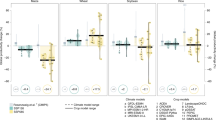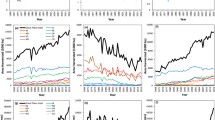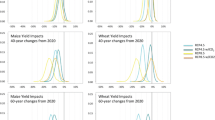Abstract
Crop production would decline in the Midwestern United States from climate change following a regional nuclear conflict between India and Pakistan. Using Agro-IBIS, a dynamic agroecosystem model, we simulated the response of maize and soybeans to cooler, drier, and darker conditions from war-related smoke. We combined observed climate conditions for the states of Iowa, Illinois, Indiana, and Missouri with output from a general circulation climate model simulation that injected 5 Tg of elemental carbon into the upper troposphere. Both maize and soybeans showed notable yield reductions for a decade after the event. Maize yields declined 10–40 % while soybean yields dropped 2–20 %. Temporal variation in magnitude of yield for both crops generally followed the variation in climatic anomalies, with the greatest decline in the 5 years following the 5 Tg event and then less, but still substantial yield decline, for the rest of the decade. Yield reduction for both crops was linked to changes in growing period duration and, less markedly, to reduced precipitation and altered maximum daily temperature during the growing season. The seasonal average of daily maximum temperature anomalies, combined with precipitation and radiation changes, had a quadratic relationship to yield differences; small (0 °C) and large (−3 °C) maximum temperature anomalies combined with other changes led to increased yield loss, but medium changes (−1 °C) had small to neutral effects on yield. The exact timing of the temperature changes during the various crop growth phases also had an important effect.








Similar content being viewed by others
References
Ainsworth EA, Ort DR (2010) How do we improve crop production in a warming world? Plant Physiol 154:526–530
Donner SD, Kucharik CJ (2003) Evaluating the impacts of land management and climate variability on crop production and nitrate export across the Upper Mississippi Basin. Global Biogeochem Cycles 17(3):1085. doi:10.1029/2001GB001808
Ehrlich PR, Harte J, Harwell MA, Raven PH, Sagan C, Woodwell GM, Berry J, Ayensu ES, Ehrlich AH, Eisner T, Gould Sl, Grover HD, Herrera R, May RM, Mayr E, McKay CP, Mooney HA, Myers N, Pimentel D, Teal JM (1983) Long-term biological consequences of nuclear war. Science 222:1293–1300
Foley JA, Prentice IC, Ramunkutty N, Levis S, Pollard D, Sitch S, Haxeltine A (1996) An integrated biosphere model of land surface processes, terrestrial carbon balance and vegetation dynamics. Global Biogeochem Cycles 10:603–628
Harington CR (ed) (1992) The year without a summer? World climate in 1816. Canadian Museum of Nature, Ottawa, p 576
Harwell MA, Cropper WP (1985) Potential effects of nuclear war on agricultural productivity. In: Harwell MA, Hutchinson TC (eds) SCOPE 28—environmental consequences of nuclear war volume II: ecological and agricultural effects. John Wiley and Sons, New York, pp 271–355
Kucharik CJ (2003) Evaluation of a process-based agro-ecosystem model (Agro-IBIS) across the U.S. cornbelt: simulations of the inter-annual variability in maize yield. Earth Interact 7:1–33
Kucharik CJ (2006) A multidecadal trend of earlier corn planting in the central U.S. Agron J 98:1544–1550
Kucharik CJ (2008) Contribution of planting date trends to increased maize yields in the central United States. Agron J 100:328–336. doi:10.2134/agronjnl2007.0145
Kucharik CJ, Brye KR (2003) Integrated BIosphere Simulator (IBIS) yield and nitrate loss predictions for Wisconsin maize receiving varied amounts of nitrogen fertilizer. J Environ Qual 32:247–268
Kucharik CJ, Twine TE (2007) Residue, respiration, and residuals: evaluation of a dynamic agroecosystem model using eddy flux measurements and biometric data. Agric For Meteorol 146:134–158. doi:10.1016/j.agrformet.2007.05.011
Kucharik CJ, Foley JA, Delire C, Fisher VA, Coe MT, Gower ST, Lenters J, Molling C, Norman JM, Ramankutty N (2000) Testing the performance of a dynamic global ecosystem model: water balance, carbon balance, and vegetation structure. Global Biogeochem Cycles 14:795–825
Lobell DB, Field CB (2007) Global scale climate-crop yield relationships and the impacts of recent warming. Environ Res Lett 2:014002
Lobell DB, Burke MB, Tebaldi C, Mastrandrea MD, Falcon WP, Naylor RL (2008) Prioritizing climate change adaptation needs for food security in 2030. Science 319:607–610
Lopes M, Araus JL, van Heerden PDR, Foyer CH (2011) Enhancing drought tolerance in C4 crops. J Exp Bot 62(9):3135–3153. doi:10.1093/jxb/err105
Mills MJ, Toon OB, Turco RP, Kinnison DE, Garcia RR (2008) Massive global ozone loss predicted following regional nuclear conflict. P Nat Acad Sci 105:5307–5312
National Agricultural Statistics Service (NASS) (2011) Environmental database—http://www.nass.usda.gov/Statistics_by_Subject/Environmental/index.asp
Oppenheimer C (2003) Climatic, environmental and human consequences of the largest known historic eruption: Tambora volcano (Indonesia) 1815. Prog Phys Geogr 27(2):230–259
Post JD (1977) The last great subsistence crisis in the western world. The Johns Hopkins University Press, Baltimore, p 240
Robock A (1988) Enhancement of surface cooling due to forest fire smoke. Science 242:911–913
Robock A (1991) Surface cooling due to forest fire smoke. J Geophys Res 96:20,869–20,878
Robock A, Oman L, Stenchikov GL, Toon OB, Bardeen C, Turco RP (2007) Climatic consequences of regional nuclear conflicts. Atm Chem Phys 7:2003–2012
Sacks WJ, Kucharik CJ (2011) Trends in crop management and phenology in the U.S. corn belt, and impacts on yields, evapotranspiration, and energy balance. Agric For Meteorol. doi:10.1016/j.agrformet.2011.02.010
Schmidt GA, Ruedy R, Hansen JE et al (2006) Present-day atmospheric simulations using GISS ModelE: comparison to in situ, satellite, and reanalysis data. J Clim 19:153–192
Sinclair TR (1986) Simulated soya bean production during the recovery phase of a nuclear winter. Agr Ecosyst Environ 17:181–185
Spitters CJT (1986) Separating the diffuse and direct component of global radiation and its implications for modeling canopy photosynthesis Part II. Calculation of canopy photosynthesis. Agr Forest Meteorol 38(1–3):231–242
Stommel H, Stommel E (1979) The year without a summer. Sci Am 240:176–186
Tollenaar M, Lee EA (2010) Strategies for enhancing grain yield in maize. In: Janick J (ed) Plant breeding reviews, vol 34. John Wiley & Sons, Inc, Hoboken. doi:10.1002/9780470880579.ch2
Toon OB, Robock A, Turco RP (2008) Environmental consequences of nuclear war. Phys Today 61(12):37–42
Twine TE, Kucharik CJ (2008) Evaluating a terrestrial ecosystem model with satellite information of greenness. J Geophys Res 113:G03027. doi:10.1029/2007JG000599
Xia L, Robock A (2012) Impacts of nuclear war in South Asia on rice production in Mainland China, Climatic Change, this issue
Acknowledgments
We thank Luke Oman for providing us with the climate model output for Midwestern U.S. This work is partially supported by the Switzerland Federal Department of Foreign Affairs, NSF grant ATM-0730452, and NOAA grant NA08OAR4310873. Authors are also indebted to Mr. George Allez for his meticulous editing to make the article more concise. Finally, the suggestions of three anonymous reviewers significantly improved this manuscript.
Author information
Authors and Affiliations
Corresponding author
Rights and permissions
About this article
Cite this article
Özdoğan, M., Robock, A. & Kucharik, C.J. Impacts of a nuclear war in South Asia on soybean and maize production in the Midwest United States. Climatic Change 116, 373–387 (2013). https://doi.org/10.1007/s10584-012-0518-1
Received:
Accepted:
Published:
Issue Date:
DOI: https://doi.org/10.1007/s10584-012-0518-1




